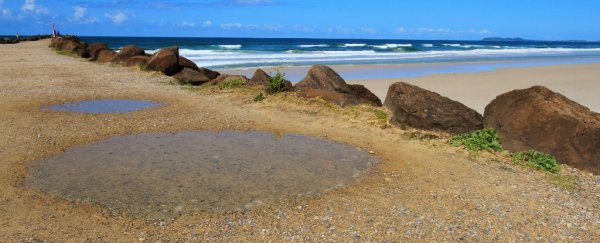Scientists have a pretty good understanding of how life evolved from simple, single-celled organisms to incredibly complex ones through countless mutations over the course of millions of years, but where did the fundamental building blocks - RNA and DNA - needed to create the first speck of life come from?
Researchers pondered this question for decades, and there's no shortage of possible answers. And now evidence has emerged that suggests the biological compounds called nucleobases needed to form proto-RNA might have formed in ancient puddles.
Yes, according to a new study by researchers from the Georgia Institute of Technology, the fundamental building blocks needed to form RNA - and, therefore, DNA - might have formed inside what they're calling "primordial puddles".
This means that life could have formed on beaches and random areas with no specific condition required, which goes against the longstanding notion that life formed in hot, fiery springs.
Since researchers agree that RNA probably came before DNA, and that ancient RNA was probably different than it is today - referred to as a proto-RNA - they knew they needed to find the molecular 'ancestor' to modern RNA.
"Early Earth was a messy laboratory where probably many molecules like those needed for life were produced. Some survived and prospered, while others eventually vanished," says one of team, Nicholas Hud. "That goes for the ancestors of RNA, too."
So, with that in mind, the team performed an experiment using a puddle of water to see if they could find the building blocks needed to form this proto-RNA under everyday conditions in the lab.
They took two ingredients that were abundant on prebiotic Earth - barbituric acid and melamine - and used them to form proto-nucleotides. "[T]he resulting nucleotides spontaneously paired with each other in water, forming hydrogen bonds like the Watson-Crick base pairs that create the 'ladder-rung' pattern inside RNA and DNA helixes," the team explains.
Next, the molecules formed long, 'supramolecular' assemblages that looked just like strands of RNA.
"There has been no reported chemical reaction so far that has produced existing components of RNA under commonplace circumstances that spontaneously form Crick-Watson pairs in water," the researchers report. "And up until now, there had also been no report of a similar pair of nucleotides - like those produced with barbituric acid and melamine - behaving in a like manner, making this another first."
This discovery hints at the possibility that barbituric acid and melamine could have been ancestors to adenine and uracil - the two nucleobases in modern RNA. While this is definitely a possibility, the team is hesitant to use the label.
"There are umpteen possibilities of how that mechanism could have happened," said Hud. "Barbituric acid and melamine may have been placeholders that dropped out and allowed adenine and uracil to come together with ribose."
The strange thing is that this reaction will not occur if the two nucleobases are in the same puddle before reacting with ribose, the "R" in RNA. Instead, the team says that they likely formed in separate puddles and were mixed together somehow, likely through the rainfall that caused puddles to join.
While it will still take some time to fully understand if these two nucleobases are ancestors to those found in today's RNA, the team's discovery offers a glimpse at how life, in its most basic form, could have started on Earth and, maybe even in other areas of the Universe. In other words, it's a very, very, big deal if someone can build on these results.
The team's findings have been published in the journal Nature Communications.
